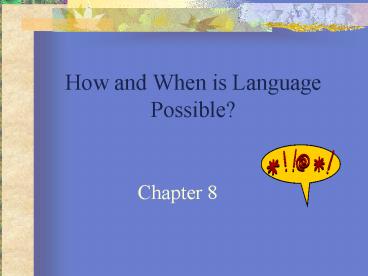How and When is Language Possible - PowerPoint PPT Presentation
1 / 19
Title:
How and When is Language Possible
Description:
Uses all four fields of anthropology. Language too ... Language probably evolved slowly along with culture. Children born with ability to learn language ... – PowerPoint PPT presentation
Number of Views:24
Avg rating:3.0/5.0
Title: How and When is Language Possible
1
How and When is Language Possible?
Chapter 8
2
How is Language Possible?
- Theories
- Defining language
- Design Features
- Primates
- Children language acquisition
- When is language possible?
- How is language possible?.
3
Contemporary Theories
- Theoretical linguistics
- Still speculative
- Language- evolved at once
- Language- innate feature in humans
- Children born with universal grammar
- Only need to acquire specifics
- Linguistic anthropology
- Uses all four fields of anthropology
- Language too complicated to have developed all at
once - Language probably evolved slowly along with
culture - Children born with ability to learn language
- Learning takes place in social situations.
4
Defining Language
5
Defining Language
- Hocketts Design Features of language
- 1960s
- Defining what is unique to humans
- Thirteen features
- Four are unique to human language.
6
Design Features of Language
- Not Unique to Humans
- Vocal/auditory channel
- Broadcast transmission / directional reception
- Rapid fading
- Interchangeability
- Total feedback
- Specialization
- Semanticity
- Arbitrariness
- Discreteness.
- Unique to Humans
- (according to Hockett)
- Displacement
- Productivity
- Traditional transmission
- Duality of patterning
- / k æ t s /.
7
Design Features and the Emergence of Human
Language
- The idea of blending
- Combining calls to establish productivity
- Starting from closed calls (limited, specific)
- A B A B
- danger food danger food
- Moving to blended calls (prelanguage)
- A B AB
- danger food dangerous food
- breakfast lunch brunch
- Making duality of patterning possible
- Isolation of units for recombining
- A B C ABC, CBA, BAC, ACB
8
Primate Communication
- Experiments
- Chimpanzees
- Gorillas
- Orangutans
- What this tells us about language
- Duality of patterning is uniquely human
- What it tells us about language origins
- Pre-language abilities of humans and other
primates probably similar.
9
Children and Language
- 3 days recognizing parents sounds
- 3 months cooing, playing with intonation
- 6 months babbling, playing with sounds
- 9 months beginning signs
- 1 year recognizable spoken words
- 15 months naming explosion
- 2 years simple sentences, displacement
- Then negatives, questions, clauses.
10
Theories about Language in Children
- Innatist theories
- Language hard-wired in brain
- Behaviorist theories
- Stimulus and reward
- Cognitivist theories
- Concepts come first
- The theory theory
- Children observe and build theories
- Different languages - different theories?
11
WHEN is Language Possible?
- Connected to HOW
- Involves research into brain
- And vocal tract
- And origins of culture.
12
The Human Brain
- Cortex
- The convoluted surface of the brain
- Two millimeters thick
- Surface area 1.5 square yards
- Contains 100 million neurons
- Oldest part of cortex
- Controls long term memory
- And emotion
- Newer part of cortex
- Neocortex
- Controls language
- 80 of human brain
- Divided into lobes
- Frontal
- Temporal
- Parietal
- Occipital.
13
Lateralization Language
- Two cerebral hemispheres
- Connected by corpus callosum
- Left hemisphere
- association
- calculation
- analysis
- language
- Right hemisphere
- touch
- space
- music
- contexts for language use.
14
Language Areas of the Brain
- Brocas area
- Clarity of speech
- Function words
- Some word order
- Wernickes area
- Understanding words
- Producing sentences.
15
The Human Vocal Tract
- Lowering of the larynx
- Where vocal cords are located
- Lengthening of the pharynx
- More space for tongue
- Increased vowel resonance
- Differentiation of vowels i a u
- Human infants born with high larynx
- Begins to lower at three months
- Reaches adult location by 3-4 years
- Except in adult males further descent at
adolescence.
16
The Fossil Record
- Evidence from basicranium
- Where muscles attach
- More curved lower larynx
- Australopithecus (1.5 mya) not curved
- Homo habilis (2 mya) no data
- Homo erectus (1.6 mya) some curve
- Early Homo sapiens (400,000 ya) definite curve
- Homo sapiens sapiens (125,000 ya) ditto
- Neanderthal (130,000 ya) no curve.
17
Origins of Culture
- Associating language with complex tools
- evolution of tool design provides clues
- complexity of Upper Paleolithic tools
- requires description (vs imitation)
- Associating language with cultural complexity
- art, music, ritual, cooperative
hunting/childcare.
18
The Fossil Record
- Australopithecus (1.5 mya) first stone tools
- Homo habilis (2 mya) control of fire
- Homo erectus (1.6 mya) organized hunting?
- Early Homo sapiens (400,000 ya) shelters, burials
- Homo sapiens sapiens (125,000 ya) knitting,
basketweaving - Neanderthal (130,000 ya) burials, music.
19
Next
- Change and Choice
- Read
- Textbook Chapter 9
- Workbook/Reader
- Haller (pp. 114-120)
- Prepare to do
- Writing/Discussion Exercises (W/R p. 120-122)
- Practice with Languages (W/R pp. 122-124)
- Language Creating (W/R p. 129)
- Conversation partnering (W/R p. 129).































